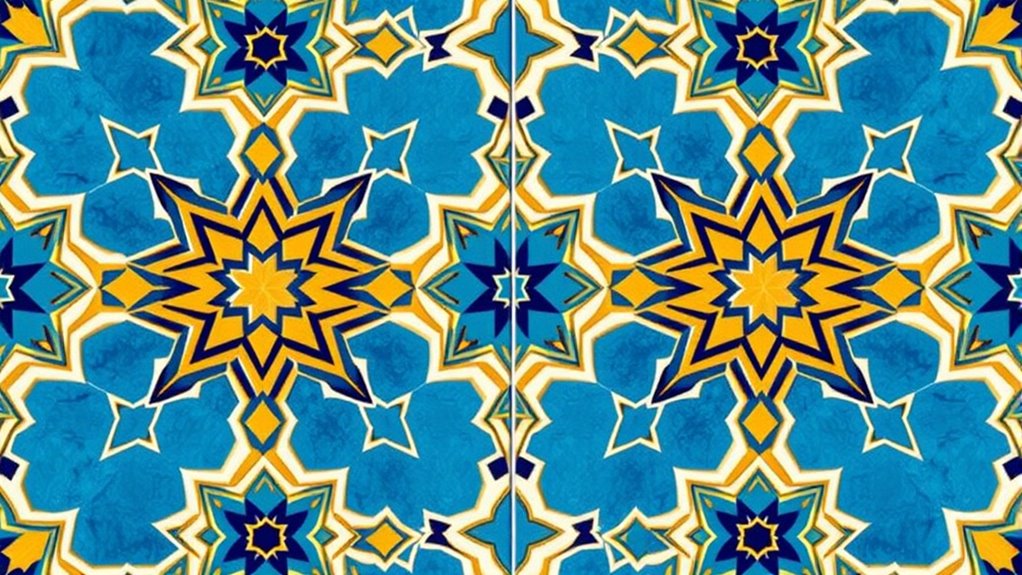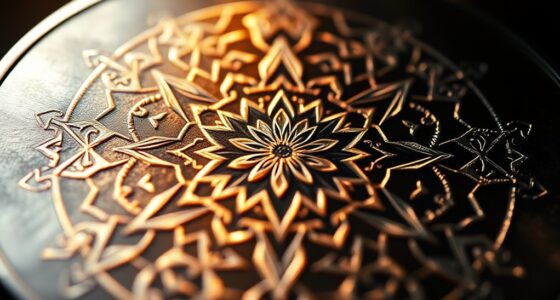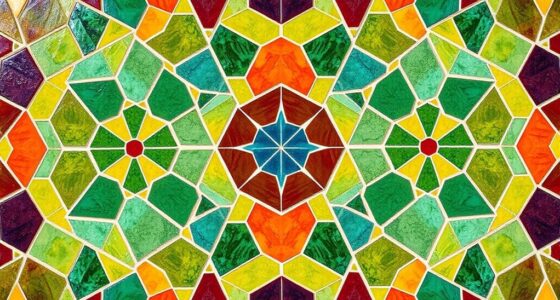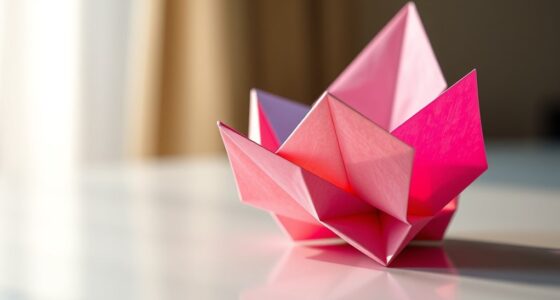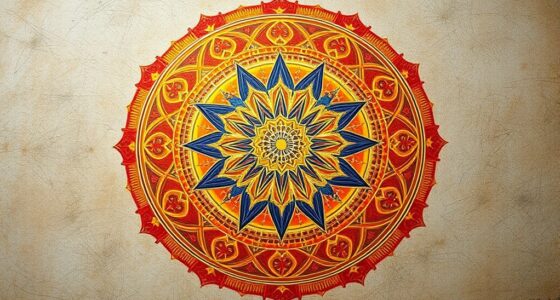You’ll find that geometric patterns in Islamic art showcase intricate designs rooted in mathematics and spirituality. They emphasize harmony, symmetry, and repetition, often merging calligraphy and sacred symbols seamlessly. These patterns reflect cultural influences from Persia, Byzantium, and Rome, evolving over centuries. They symbolize unity, infinity, and divine connection. If you keep exploring, you’ll uncover how these timeless designs continue to inspire and inform modern art and architecture.
Key Takeaways
- Islamic geometric patterns emphasize harmony, symmetry, and mathematical precision, reflecting spiritual symbolism and divine order.
- They integrate calligraphy seamlessly, blending sacred texts with decorative motifs without disrupting visual flow.
- Patterns are created using tessellation, geometric constructions, and repetition to symbolize infinity and unity.
- Regional styles vary, with influences from Persian, Byzantine, and Ottoman traditions shaping unique motifs.
- Modern artists incorporate traditional patterns into contemporary design, enhanced by digital tools for precision and creative exploration.
Origins and Historical Development of Geometric Patterns
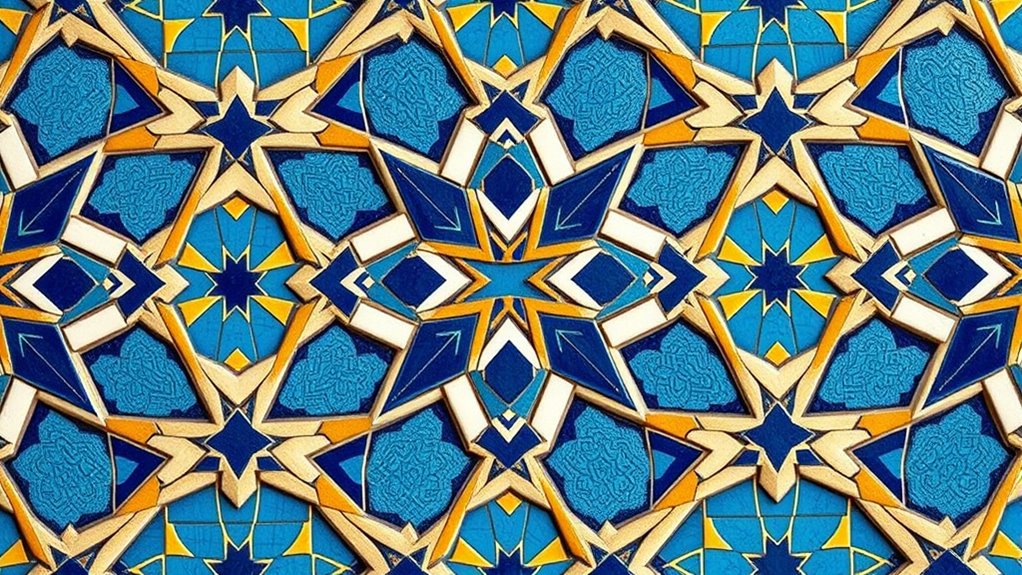
Geometric patterns in Islamic art have a rich history that dates back to the early centuries of the Islamic civilization. You’ll notice how artisans used tile mosaics to create intricate, repeating designs that emphasize harmony and order. These patterns often integrate calligraphy seamlessly, blending sacred texts into decorative elements without disrupting the visual flow. Historically, this development was influenced by earlier Persian, Byzantine, and Roman artistic traditions, which inspired regional adaptations. Over time, artists refined techniques to produce increasingly complex patterns, reflecting both spiritual symbolism and mathematical ingenuity. The use of symmetry and repetition in these designs exemplifies the mathematical principles that underpin many Islamic geometric patterns. This evolution highlights a desire to represent the infinite and divine through ordered, symmetrical designs. Understanding this background helps you appreciate the deep cultural and artistic roots that shape Islamic geometric art today.
Mathematical Foundations and Techniques

At the heart of Islamic geometric patterns lies a sophisticated understanding of mathematics, which artists use to create precise and harmonious designs. You rely on symmetry principles to guarantee your patterns are balanced and aesthetically pleasing. These principles guide the repetition and reflection of shapes, maintaining harmony throughout the design. Tessellation techniques are fundamental, allowing you to interlock shapes without gaps or overlaps, creating seamless patterns. You often use geometric constructions, such as circles and polygons, to generate complex motifs with mathematical accuracy. Mastering these techniques enables you to produce intricate, mesmerizing patterns that reflect order and unity. By applying mathematical foundations, your art transcends decoration, embodying a disciplined, systematic approach to beauty rooted in geometry. Additionally, understanding basic geometric shapes helps you develop more complex and visually engaging patterns that resonate with viewers.
Symbolism and Spiritual Significance
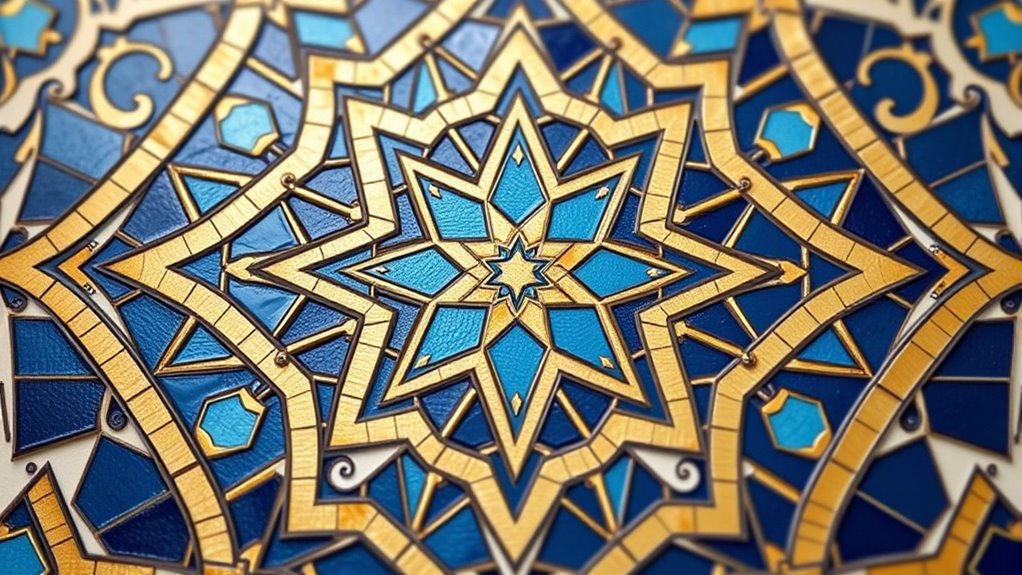
Have you ever wondered why certain patterns recur across Islamic art? These patterns often embody deep spiritual symbolism, reflecting the divine nature of the universe. You’ll notice how calligraphic integration weaves sacred texts into geometric designs, enhancing their spiritual significance. These motifs serve as visual metaphors for unity, infinity, and the eternal connection between the divine and the human. The repetitive nature of the patterns symbolizes the infinite nature of Allah and the universe’s continuous creation. By engaging with these designs, you participate in a form of spiritual reflection, seeing the divine reflected in intricate forms. The patterns aren’t just decoration; they’re a visual language conveying profound spiritual truths, inviting contemplation and connecting the viewer with higher realities. Additionally, the use of geometric patterns in Islamic art is often achieved through meticulous craftsmanship, emphasizing the importance of precision and harmony in expressing spiritual concepts.
Regional Variations and Styles

Across different regions within the Islamic world, geometric patterns showcase a rich tapestry of styles that reflect local cultural influences and historical developments. You’ll notice how tile motifs vary from one area to another, revealing regional influences that shape design choices. In Persia, intricate star shapes and floral-inspired patterns dominate, while North African designs emphasize bold, repetitive motifs with vibrant colors. Ottoman art often incorporates complex interlacing patterns, blending geometric precision with calligraphic elements. These regional variations aren’t random; they result from unique cultural interactions, climate, and available materials. Additionally, cultural exchange through trade routes significantly contributed to the diversity of design motifs across regions. By examining tile motifs across regions, you can appreciate how local traditions, trade routes, and historical contexts influence the development of Islamic geometric art, creating diverse yet cohesive visual expressions.
Contemporary Interpretations and Influences
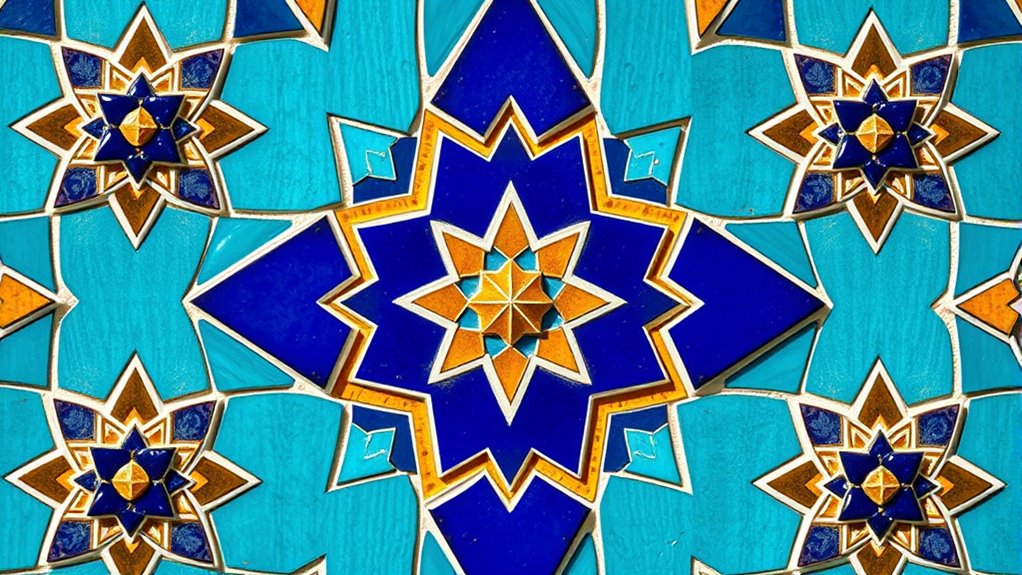
Contemporary artists and designers continue to draw inspiration from traditional Islamic geometric patterns, blending them with modern aesthetics and techniques. They incorporate these patterns into modern design, creating fresh visuals that honor historical roots while appealing to current sensibilities. Digital adaptation plays a key role, enabling intricate patterns to be manipulated and reproduced with precision using software tools. This fusion results in innovative artworks, textiles, architecture, and digital media that reflect a dynamic dialogue between tradition and innovation. By experimenting with scale, color, and form, artists push the boundaries of classical motifs, making them relevant in today’s visual culture. These contemporary interpretations demonstrate how Islamic geometric patterns evolve, influencing design trends and inspiring new creative expressions across various mediums. Additionally, understanding the symbolism and significance behind these patterns enriches their contemporary applications and interpretations.
Frequently Asked Questions
How Are Geometric Patterns Preserved During Restoration Processes?
When you restore intricate designs, you rely on specialized techniques like careful cleaning, color matching, and reversible methods to guarantee the patterns stay intact. Preservation challenges include avoiding damage and maintaining authenticity. You must balance restoring the artwork without compromising its original quality. By using these careful restoration techniques, you help preserve the beauty and integrity of the patterns for future generations, ensuring they remain as vibrant and accurate as the original.
What Tools Do Artisans Use to Create Intricate Designs?
To create intricate designs, you use a mix of traditional tools and modern techniques. Traditional tools like compasses, rulers, and calligraphy brushes help you draw precise geometric patterns by hand. You might also use modern techniques such as computer-aided design (CAD) software to plan and refine your work before transferring it onto surfaces. This combination guarantees your intricate patterns are accurate, detailed, and beautifully executed.
Are There Specific Colors Associated With Certain Patterns?
You might notice that certain colors carry specific meanings, or color symbolism, in patterns. For example, blue often represents spirituality or protection, while green symbolizes paradise or fertility. These colors enhance pattern symbolism, conveying deeper spiritual or cultural messages. When creating or appreciating intricate designs, understanding these color associations helps you see how artisans use hue intentionally, enriching your appreciation of the art’s layered meanings and cultural significance.
How Do Patterns Influence Architectural Acoustics?
You might notice that patterns influence architectural acoustics by enhancing sound reflection and guiding how sound waves travel within a space. When you incorporate specific patterns, they can help with acoustic optimization, reducing echoes and improving clarity. These designs manipulate surfaces to reflect sound effectively, making spaces more comfortable for speech, music, or prayer. By understanding pattern placement, you can create environments that better manage sound and improve overall acoustic quality.
Can Visitors Learn to Create Geometric Patterns Themselves?
You can definitely learn to create geometric patterns yourself. Many workshops and tutorials teach you how to draw these intricate designs, helping you understand their pattern symbolism and cultural significance. As you practice, you’ll see how each pattern reflects deeper meanings and traditions. Engaging actively in creating these patterns allows you to connect with the cultural stories behind them, gaining a greater appreciation for their artistic and cultural importance.
Conclusion
By exploring geometric patterns in Islamic art, you see how math and spirituality intertwine, creating intricate beauty that transcends borders. These designs reflect a divine order, inviting you to find harmony in complexity. As the saying goes, “Beauty lies in the details,” reminding you that understanding these patterns deepens your appreciation for their cultural and spiritual richness. Embrace their timeless elegance, and you’ll uncover a universe where art, faith, and mathematics unite seamlessly.
